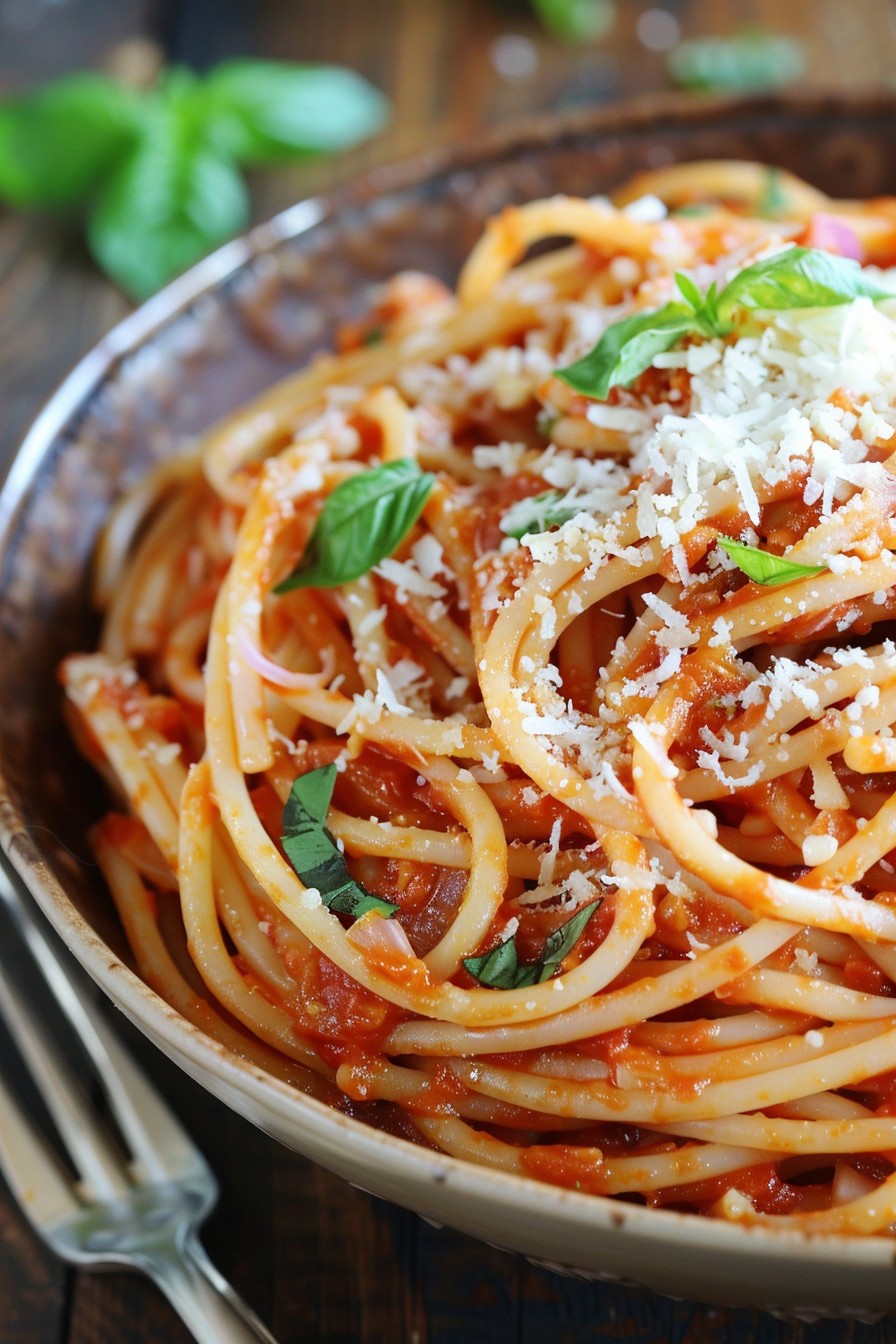Mmm, spaghetti! There’s nothing quite like twirling those long, luscious noodles around your fork, especially when they’re coated in a rich, flavorful sauce. Whether you’re a kitchen newbie or a seasoned chef, this spaghetti recipe is sure to impress. Let’s dive into making a dish that’s as fun to prepare as it is to eat.
Why This Recipe Works
- Perfect Pasta Texture: By salting the water and cooking the spaghetti al dente, you ensure each bite has the ideal chewiness.
- Flavorful Sauce: A combination of garlic, onions, and tomatoes simmered together creates a depth of flavor that’s hard to resist.
- Easy to Customize: Whether you’re adding meat, veggies, or keeping it simple, this recipe serves as a versatile base for endless variations.
Ingredients
- 1 pound spaghetti
- 2 tablespoons olive oil
- 3 cloves garlic, minced
- 1 medium onion, finely chopped
- 1 can (28 ounces) crushed tomatoes
- Salt and pepper to taste
- 1/4 cup fresh basil, chopped
- Parmesan cheese for serving
Equipment Needed
- Large pot
- Colander
- Large skillet
- Wooden spoon
- Measuring cups and spoons
Instructions

Boil the Pasta to Perfection
Fill a large pot with water and bring it to a rolling boil. Add a generous pinch of salt—this is your only chance to season the pasta itself. Add the spaghetti and cook for 8-10 minutes, or until al dente. Reserve a cup of pasta water before draining.
Sauté the Aromatics
Heat olive oil in a large skillet over medium heat. Add the garlic and onion, sautéing until they’re soft and fragrant, about 3-4 minutes. This builds the flavor base for your sauce.
Simmer the Sauce
Stir in the crushed tomatoes and bring the mixture to a simmer. Let it cook for about 15 minutes, allowing the flavors to meld. Season with salt and pepper to taste.
Combine Pasta and Sauce
Add the drained spaghetti to the skillet with the sauce. Toss everything together, adding a splash of reserved pasta water if needed to loosen the sauce. The starch in the water helps the sauce cling to the pasta.
Garnish and Serve
Remove from heat and stir in the fresh basil. Serve immediately with a generous sprinkle of Parmesan cheese on top.
Tips and Tricks
For an even more flavorful dish, consider toasting the spaghetti in a dry pan before boiling. This adds a nutty depth to the pasta. Always reserve pasta water—it’s a secret weapon for adjusting sauce consistency. And don’t rinse your pasta after draining; the starch helps the sauce stick. Experiment with different herbs or add a pinch of red pepper flakes for heat. Remember, the key to great spaghetti is in the details.
Recipe Variations
- Meat Lover’s Delight: Brown some ground beef or Italian sausage and add it to the sauce for a hearty twist.
- Veggie Packed: Stir in sautéed mushrooms, bell peppers, or zucchini for a nutritious boost.
- Creamy Version: Mix in a splash of heavy cream or dollop of ricotta cheese for a richer sauce.
- Seafood Spaghetti: Top with cooked shrimp or clams for a luxurious seafood pasta.
Frequently Asked Questions
Can I use fresh tomatoes instead of canned?
Absolutely! You’ll need about 2 pounds of fresh tomatoes. Blanch them to remove the skins, then chop and simmer as you would with canned. The flavor will be fresher but may require a bit more cooking time to thicken.
How do I know when the pasta is al dente?
Al dente pasta should be tender but still have a slight bite to it. Start tasting a minute or two before the package’s suggested cooking time. It’s better to err on the side of undercooked, as you can always cook it a bit more.
Can I make this recipe gluten-free?
Yes, simply substitute the regular spaghetti with your favorite gluten-free pasta. Just be mindful of cooking times, as gluten-free pasta can vary significantly in texture and cooking requirements.
Summary
This spaghetti recipe is a celebration of simplicity and flavor. With a few basic ingredients and some love, you can create a dish that’s both comforting and exciting. Perfect for weeknight dinners or special occasions, it’s a recipe you’ll return to time and again.